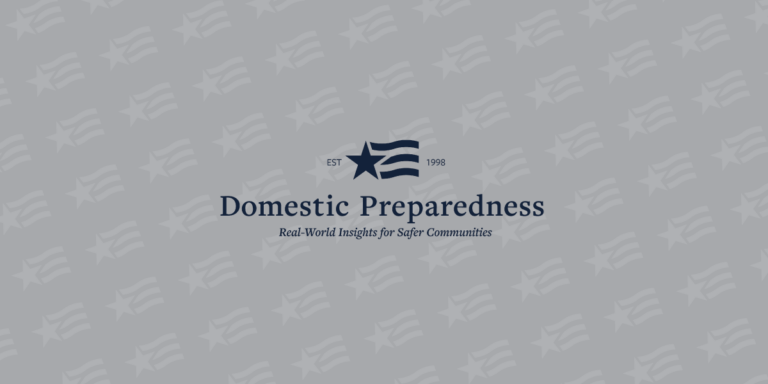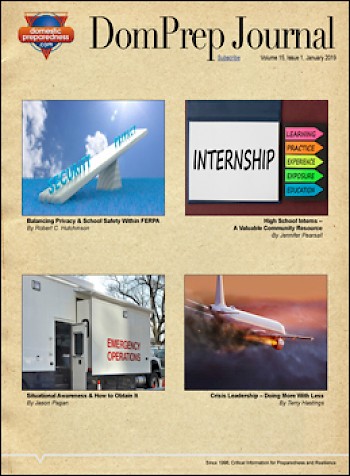
Author Archive

The Ready or Not: Protecting the Public’s Health From Diseases, Disasters and Bioterrorism series has tracked public health emergency preparedness in the United States since 2003. The series documents progress in the nation’s level of preparedness as well as those areas still in need of improvement. https://www.tfah.org/wp-content/uploads/2019/02/Ready-or-Not-Report-2019.pdf

Ready or Not: Protecting the Public’s Health From Diseases, Disasters and Bioterrorism 2019
Domestic Preparedness
February 18, 2019
The Ready or Not: Protecting the Public’s Health From Diseases, Disasters and Bioterrorism series has tracked public health emergency preparedness in the United States since 2003. The series documents progress in the nation’s level of preparedness as well as those areas still in need of improvement. https://www.tfah.org/wp-content/uploads/2019/02/Ready-or-Not-Report-2019.pdf

DoD Directive 5101.20E – DoD Biological Select Agents and Toxins (BSAT) Biosafety and Biosecurity Program
Domestic Preparedness
February 11, 2019
This issuance establishes policy and assigns responsibilities for the Department of Defense (DoD) Biological Select Agents and Toxins (BSAT) Security Program and designates the Secretary of the Army as the DoD Executive Agent for the program. https://www.esd.whs.mil/Portals/54/Documents/DD/issuances/dodd/510120p.pdf?ver=2019-01-25-090439-533

DoD Directive 5101.20E – DoD Biological Select Agents and Toxins (BSAT) Biosafety and Biosecurity Program
Domestic Preparedness
February 11, 2019
This issuance establishes policy and assigns responsibilities for the Department of Defense (DoD) Biological Select Agents and Toxins (BSAT) Security Program and designates the Secretary of the Army as the DoD Executive Agent for the program. https://www.esd.whs.mil/Portals/54/Documents/DD/issuances/dodd/510120p.pdf?ver=2019-01-25-090439-533

Building Cultures of Preparedness: A Report for the Emergency Management Higher Education Community
Domestic Preparedness
February 8, 2019
This report presents a culture-based approach to the preparedness goals laid out in the Federal Emergency Management Agency’s 2018-2022 Strategic Plan. The plan describes four guiding principles for building cultures of preparedness, followed by practical strategies and examples that demonstrate successful outcomes in real-world settings. https://training.fema.gov/hiedu/docs/latest/2019_cultures_of_preparedness_report_10.22.18 final.pdf

Building Cultures of Preparedness: A Report for the Emergency Management Higher Education Community
Domestic Preparedness
February 8, 2019
This report presents a culture-based approach to the preparedness goals laid out in the Federal Emergency Management Agency’s 2018-2022 Strategic Plan. The plan describes four guiding principles for building cultures of preparedness, followed by practical strategies and examples that demonstrate successful outcomes in real-world settings. https://training.fema.gov/hiedu/docs/latest/2019_cultures_of_preparedness_report_10.22.18 final.pdf

Fourth Generation Agents: Medical Management Guidelines
Domestic Preparedness
February 4, 2019
These guidelines were developed as part of ongoing preparedness for all hazards. They are intended to support fire, emergency medical services, and hospital staff in the medical management of patients if an incident occurs involving a fourth generation agent (FGA, also known as A-series or Novichok nerve agents), such as

Fourth Generation Agents: Medical Management Guidelines
Domestic Preparedness
February 4, 2019
These guidelines were developed as part of ongoing preparedness for all hazards. They are intended to support fire, emergency medical services, and hospital staff in the medical management of patients if an incident occurs involving a fourth generation agent (FGA, also known as A-series or Novichok nerve agents), such as

January 2019
Domestic Preparedness
January 30, 2019
Featured in this issue: Force Multipliers for Public Safety, By Catherine L. Feinman; Balancing Privacy & School Safety Within FERPA, By Robert C. Hutchinson; High School Interns – A Valuable Community Resource, By Jennifer Pearsall; Situational Awareness & How to Obtain It, By Jason Pagan; Crisis Leadership – Doing More

National Health Security Strategy 2019-2022
Domestic Preparedness
January 24, 2019
Our nation faces diverse and evolving health security threats that have the potential to disrupt our public health and health care systems and inflict injury and loss of life on our people. The National Health Security Strategy (NHSS) provides a vision for strengthening our nation’s ability to prevent, detect, assess,
Follow Us
Get Instant Access
Subscribe today to Domestic Preparedness and get real-world insights for safer communities.
ARchives
Article Out Loud – Taking Flight – Creating a Robust Aviation Response, Part 1
September 28, 2022
General aviation pilots have been finding ways to assist their communities during emergencies and disasters for many years. However, over the past two years, significant advances in disaster preparedness have been made as emergency response plans were created and exercised to integrate volunteer aviation response into other community response efforts.
Article Out Loud – Building Resource Capacity – Start Now
September 21, 2022
Building resource capacity involves research, planning, and execution that should begin now. Identifying potential dangers, considering “what if” scenarios, capitalizing on other events and incidents, and overcoming barriers are key components for building resilient communities. This article explains how to get started.
Article Out Loud – Tribal Nations Test Their Communications Capabilities
September 21, 2022
A 9.0-magnitude earthquake is a predictable scenario along the Cascadia Subduction Zone. This article describes how the tribal nations in the Pacific Northwest are preparing their region for this catastrophic event. This exercise allowed tribal and non-tribal participants to evaluate their resources and test their communications capabilities.
Article Out Loud – Smallpox – Still a Viable Bioterrorist Threat
September 20, 2022
Before passenger aircraft were hijacked and used as weapons, and bombs were smuggled inside underwear and shoes, such attacks may not have seemed likely to occur.
Article Out Loud – Joplin & Irene Force Changes in Hospital Evac Plans
September 20, 2022
Two major weather events that occurred earlier this year will be long remembered not only by meteorologists and historians but by the general public as well. Tornadoes struck the city of Joplin without warning and destroyed everything in their paths.
Article Out Loud – Respecting Tribal Emergency Management
September 14, 2022
Emergency management professionals are tasked with making their communities more resilient to future threats and disasters. However, emergency management leaders and their organizations must adjust and adapt to more than just response scenarios.
Article Out Loud – Uvalde Shooting – A Predictable Surprise
September 14, 2022
When intentional acts of violence occur, people often wonder if the incident was preventable. For example, after a mass shooting killed 19 students and 2 teachers in Uvalde, Texas, on May 24, 2022, many were questioning the predictability of the gunman’s actions and the decision-making process of the responders.
Article Out Loud – Active Shooter – When Lock Down Is Not Enough
September 13, 2022
Law enforcement officers, paramedics, and other responders have received extensive training in dealing with active shooters and the wounds resulting from active shooter incidents. However, the potential force multipliers in all these attacks that are just beginning to receive attention are the potential victims at the scene.
Article Out Loud – Emergency Animal Sheltering Options
September 13, 2022
When there is a need for sheltering animals, there are several options – each comes with advantages and disadvantages. Conditions, agency policies, experiences, resources, or timing typically drive the decision as to what type of shelter is used.
Article Out Loud – Strategic Depth & the Fight Against Violent Extremism
September 7, 2022
Despite the deaths of Islamic State and al-Qaida leadership, violent extremism is not gone. This article describes why, despite recent successful strikes against terrorist groups, intelligence agencies and others tasked with protecting their communities must stay vigilant.
Follow Us
Get Instant Access
Subscribe today to Domestic Preparedness and get real-world insights for safer communities.


